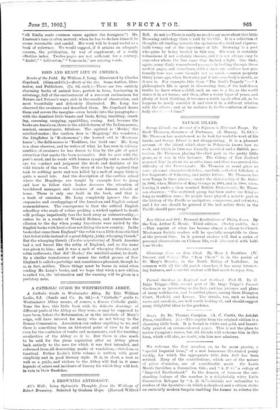BIRD AND BEAST LIFE IN AMERICA.
Beasts of the Field. By William J. Long. Illustrated by Charles Copeland. (Ginn and Co.)—Birds of the Air. Same Author, Illus- trator, and Publishers. (7s. 6d. each.)—These are two entirely charming books of animal lore ; perfect in form, fascinating in substance, full of the enchantment of a reverent enthusiasm for Nature and Nature's ways, rich in the results of observation, and most beautifully and delicately illustrated. Mr. Long has observed the creatures and described them. Mr. Copeland draws them and covers the margins—even breaks into the paragraphs— with the daintiest little beasts and birds, flying, tumbling, crawl- ing, caressing, snapping, squabbling, cooing. And, because the books are American, there is the added charm of the Indian names, musical, onomatopceic, fabulous. The squirrel is Meeko,' the mischief-maker; the caribou deer is Megaleep,' the wanderer ; the kingfisher is Koskomenos ' ; the horned owl is Kookoos- k000s ' ; the field-mouse is Tookhees, the 'fraid one.' Mr. Long is a close observer, and he writes of what he has seen in solitary rambles, of creatures he has drawn to him by the gift of quiet attraction that marks the born naturalist. But he sees with the poet's mind, and he reads with human sympathy and a moralist's eye for conduct and judgment the deeds and destinies of his wild friends of the wood. The story of the lonely squirrel that took to robbing nests and was killed by a mob of angry birds is quite a moral tale. And the description of the caribou school where the Megaleeps are taught by example how to jump and how to follow their leader deserves the attention of bewildered managers and teachers of our human schools at home. There is only one fault in the book, and that is a fault of omission. Mr. Long completely ignores the dis- crepancies and overlappings of the American and English animal nomenclatures. The consequence is that the critical English schoolboy who reads of robins pecking a wicked squirrel to death will perhaps impatiently toss the book away as untrustworthy,— unless he is a reader of Wendell Holmes, and remembers the allusion to the day when young Americans were misled by the English books with local colour not fitting the new country. In the books that came from England "the robin was a little domestic bird that fed at table instead of a great fidgety, jerky, whooping thrush." But the whooping thrush (Turdus migratorius) of North America had a red breast like the robin of England, and so the name was given to him; and it was a mob of whooping thrushes, not robin redbreasts, that did Meeko,' the mischief-maker, to death. By a similar transference of names the ruffed grouse of New England is called a partridge and sometimes a pheasant, though he is, in fact, neither. These things must be borne in mind when reading Mr. Long's books, and we hope that when a new edition is called for, the information and the warning will be given in a prefatory note.






































 Previous page
Previous page